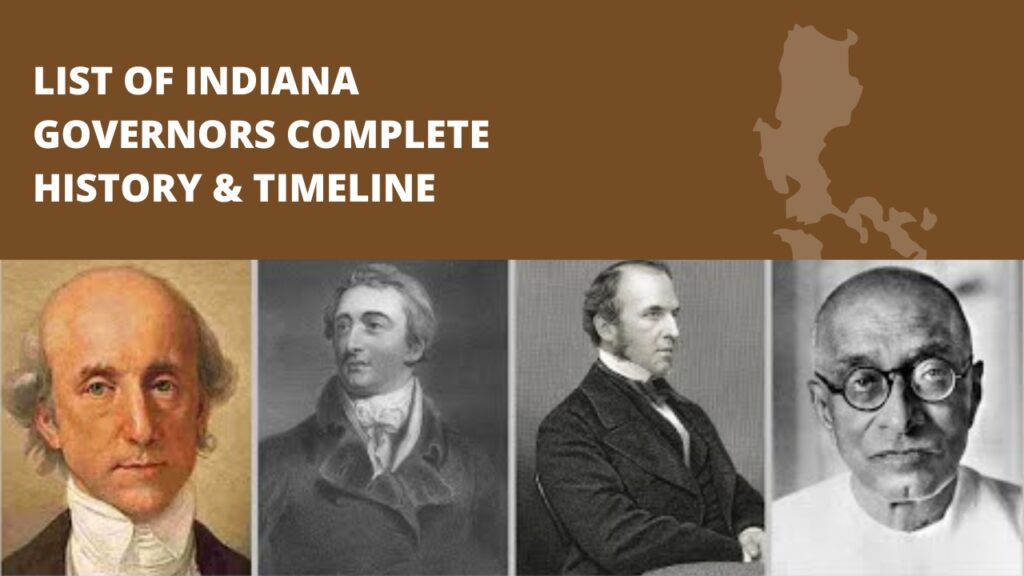Indiana, a state rich in history, culture, and diversity, has been shaped by the leadership of numerous governors since its founding. Each governor has played a unique role in guiding the state through times of growth, war, industrialization, and modernization. From the early years of statehood to the present day, the list of governors of Indiana reflects not just political succession but also the social, economic, and cultural evolution of the state.
The journey of Indiana’s governors is not merely a chronological record; it is a living testament to resilience, reform, and progress. By understanding this leadership timeline, we can gain insight into the challenges faced, the decisions made, and the legacies left behind. This history helps us appreciate how past leadership continues to influence Indiana’s path forward.
Governors of Indiana
The list of governors of Indiana, spanning from the early 19th century to the present, begins with Jonathan Jennings, the state’s first governor. He was followed by Ratliff Boon, Noah Noble, David Wallace, Samuel Bigger, James Whitcomb, Paris Dunning, Joseph A. Wright, Ashbel P. Willard, and Abram A. Hammond. Leadership then passed to Henry S. Lane, Oliver P. Morton, Conrad Baker, Thomas A. Hendricks, Claude Matthews, Isaac P. Gray, Alvin P. Hovey, Winfield T. Durbin, James A. Mount, and Claude E. Wilson.
Indiana’s governance continued with Warren T. McCray, Emmett F. Branch, Harry G. Leslie, Paul V. McNutt, M. Clifford Townsend, Ralph F. Gates, George N. Craig, Harold W. Handley, Henry F. Schricker, George M. Craig, and Roger D. Branigin. The mid to late twentieth century saw leaders such as Edgar D. Whitcomb, Otis R. Bowen, Robert D. Orr, Evan Bayh, Frank O’Bannon, and Joe Kernan. In more recent years, Indiana has been led by Mitch Daniels, Mike Pence, and the current governor, Eric Holcomb.
Jonathan Jennings
As Indiana’s first governor, Jennings had the responsibility of shaping the state’s early identity. Beyond establishing state institutions, he strongly advocated for education, particularly through his efforts to establish Indiana University. Jennings’ legacy is that of a visionary who laid the groundwork for a structured government and the promotion of learning as a foundation for state development.
Ratliff Boon
Ratliff Boon is remembered for his commitment to economic progress. His most notable achievement was championing the construction of the Wabash and Erie Canal, a project that transformed trade and commerce within Indiana. His leadership not only improved infrastructure but also strengthened the state’s financial stability, ensuring Indiana could sustain growth during its formative years.
Noah Noble
Governor Noble’s tenure is often highlighted for his strong commitment to public education. He spearheaded the Indiana School Fund, which provided consistent financing for education, a groundbreaking move at the time. Noble’s leadership also included judicial reforms, reflecting his determination to strengthen both governance and legal systems in the state.
David Wallace
David Wallace is remembered not just as a political leader but also as a cultural advocate. During his term, he played a key role in preserving Indiana’s history, particularly through the establishment of the Indiana Historical Society. His contributions extended beyond politics into ensuring the heritage of Indiana would be protected for generations.
Samuel Bigger
Bigger’s administration centered around infrastructure and internal improvements. His efforts to construct new roads and support development projects reflected his belief that better connectivity would ensure economic prosperity. Beyond the governorship, his role in Congress and the Indiana Senate further emphasized his dedication to public service.
James Whitcomb
Whitcomb’s legacy is defined by education and progress during wartime. He helped create Indiana’s state library and supported the establishment of a state board of education. His administration coincided with the Mexican-American War, during which he balanced military support with domestic improvements to ensure long-term growth.
Paris Dunning
Leading Indiana at the brink of the Civil War, Dunning faced a divided state with both Union supporters and Southern sympathizers. His leadership ensured Indiana’s loyalty to the Union cause, reflecting both political courage and a commitment to national unity at a time of uncertainty.
Joseph A. Wright
Joseph Wright’s term is deeply tied to the Civil War era. He actively managed state resources and supported Union troops, ensuring Indiana played a vital role in the war effort. Wright is remembered as one of the governors who held Indiana together in one of the most difficult periods of American history.
Ashbel P. Willard
After the war, Governor Willard’s administration concentrated on reconstruction. His leadership focused on rebuilding Indiana’s economy, reintegrating soldiers into society, and strengthening the state’s position within the Union. His term reflected both resilience and a forward-looking vision for Indiana’s recovery.
Abram A. Hammond
Hammond’s primary focus was on improving Indiana’s finances. He worked diligently to reduce government expenses and resolve state debt issues. By implementing financial discipline, he laid a strong foundation for Indiana’s economic future.
Henry S. Lane
Governor Lane’s leadership was characterized by unity and political transformation. He was a prominent figure in the establishment of the Republican Party in Indiana, reshaping the political landscape of the state. His brief tenure reflected the spirit of post-war unity and progress.
Oliver P. Morton
Often referred to as “The Soldiers’ Friend,” Morton’s leadership during the Civil War was pivotal. He mobilized troops, secured resources, and ensured Indiana remained firmly in support of the Union. His unwavering leadership during wartime cemented his place as one of the most influential governors in the state’s history.
Conrad Baker
Baker’s administration marked a shift from war to reconstruction. He focused on supporting veterans, rebuilding communities, and strengthening public welfare. By balancing economic growth with compassion for war-affected families, Baker ensured a smoother post-war recovery for Indiana.
Thomas A. Hendricks
Before becoming Vice President of the United States, Hendricks made significant contributions as governor. His policies centered on economic growth and attracting new industries to Indiana. His vision helped diversify the state’s economy during an era of rapid industrialization.
Claude Matthews
Matthews’ leadership brought modernization to Indiana. He focused on attracting new businesses, improving transportation systems, and encouraging industrial growth. His term reflected the state’s shift toward modernization and competitiveness in the wider American economy.
Isaac P. Gray
Governor Gray played a critical role in fostering industrial development. His economic policies supported business expansion and job creation, making Indiana an attractive destination for entrepreneurs and workers alike. His legacy lies in ensuring financial stability and industrial progress.
Alvin P. Hovey
Hovey’s governorship coincided with the difficult process of post-war healing. His efforts focused on reconciling divisions and promoting unity, while also pushing forward with policies that encouraged industrial development.
Winfield T. Durbin
Durbin emphasized both economic and social reform. His administration pushed for industrial expansion while addressing welfare needs, ensuring that growth was balanced with the well-being of Indiana residents.
James A. Mount
Mount worked on diversifying Indiana’s economy and strengthening agriculture alongside industry. His policies attracted new investments while maintaining a focus on building a stable and sustainable economic base.
Claude E. Wilson
Wilson took a balanced approach, promoting business growth while investing in education and infrastructure. His policies reflected an understanding that true progress requires both economic opportunity and strong social systems.
Warren T. McCray
McCray oversaw a period of transition and initiated bold infrastructure projects to create jobs and support long-term growth. His forward-thinking approach ensured that Indiana continued to move toward modernization.
Emmett F. Branch
Branch viewed education as a cornerstone of progress. His reforms strengthened Indiana’s school system, ensuring that future generations would be equipped to support economic and social development.
Harry G. Leslie
Serving during a difficult economic period, Leslie introduced policies aimed at recovery and stabilization. By promoting job creation and supporting industries, he helped Indiana navigate challenging times.
Paul V. McNutt
McNutt’s administration is remembered for balancing economic development with public welfare. He invested in social services while also attracting businesses and strengthening infrastructure. His leadership set the stage for post-war prosperity.
Clifford Townsend
Townsend focused on rebuilding after wartime hardships. His administration prioritized infrastructure recovery, industrial support, and creating employment opportunities that restored confidence in Indiana’s future.
Ralph F. Gates
Gates modernized Indiana with new business-friendly policies, transportation improvements, and educational investments. His tenure marked a step forward into a more competitive and innovative era.
George N. Craig
Craig emphasized public works and transportation projects that laid the groundwork for long-term prosperity. His leadership ensured Indiana’s place as an economic hub in the Midwest.
Harold W. Handley
Handley worked toward equity by supporting job creation and social services. His administration was known for promoting economic inclusivity and building infrastructure for future growth.
Henry F. Schricker
Schricker emphasized education as a key driver of progress. His initiatives to expand opportunities in schooling reflected his belief that education was central to Indiana’s advancement.
George M. Craig
Craig focused on balancing economic expansion with public welfare. His leadership sought to ensure growth that benefited both businesses and residents, creating a more inclusive state economy.
Roger D. Branigin
Branigin’s administration prioritized modernization, strengthening Indiana’s economic landscape and positioning the state as a competitive force during the mid-20th century.
Edgar D. Whitcomb
Whitcomb promoted industrial expansion while also improving infrastructure and welfare programs. His balanced approach ensured both economic and social well-being for Hoosiers.
Otis R. Bowen
Bowen’s leadership is often remembered for healthcare reforms and social programs that strengthened public welfare, ensuring Hoosiers had access to better healthcare services.
Robert D. Orr
Orr’s vision focused on technological growth and innovation. He played a key role in preparing Indiana for the digital era, expanding industries, and diversifying the state’s economic base.
Evan Bayh
Bayh invested in education and economic growth, creating a business-friendly environment that attracted investments. His leadership highlighted the importance of preparing Indiana for long-term prosperity.
Frank O’Bannon
O’Bannon emphasized balancing economic development with social equity. His initiatives ensured that progress was measured not just in financial terms but also in community well-being.
Joe Kernan
Kernan built upon modernization by investing in infrastructure and encouraging economic diversification. His policies reflected a commitment to fairness and progress for all Indiana residents.
Mitch Daniels
Daniels’ leadership was marked by fiscal responsibility and economic reform. His business-friendly policies helped attract investments and strengthened Indiana’s reputation as a financially stable state.
Mike Pence
Pence’s administration focused on public policy, economic development, and strengthening Indiana’s business climate. His leadership played a significant role in shaping the state’s contemporary political landscape.
Eric Holcomb
Holcomb, Indiana’s current governor, continues the tradition of modernization and global competitiveness. His administration prioritizes innovation, economic growth, and workforce development, positioning Indiana strongly for the future.
Conclusion
In conclusion, the list of governors of Indiana is more than a historical record; it is a chronicle of leadership, resilience, and progress. Each governor left a distinct imprint on the state, shaping its identity and preparing it for the challenges of tomorrow. By studying this timeline, we not only learn about Indiana’s past but also gain insights into its ongoing journey toward growth and prosperity.
FAQs
Who was the first governor of Indiana?
Jonathan Jennings served as the first governor of Indiana.
Which governor played a significant role during the Civil War?
Oliver P. Morton’s leadership was pivotal during the Civil War, earning him the title “The Soldiers’ Friend.”
How have recent governors contributed to economic development?
Governors such as Mitch Daniels and Eric Holcomb have focused on modernization, economic expansion, and fiscal responsibility to strengthen Indiana’s future.





